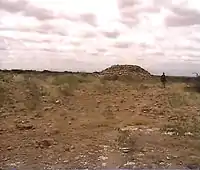Somali mythology
Somali mythology covers the beliefs, myths, legends and folk tales circulating in Somali society that were passed down to new generations in a timeline spanning several millennia. Many of the things that constitute Somali mythology today are traditions whose accuracy have faded away with time or have been gentrified considerably with the coming of Islam to the Horn of Africa.
 |
| Part of a series on the |
| Culture of Somalia |
|---|
| Culture |
| People |
| Religion |
| Language |
| Politics |
The culture of venerating saints and the survival of several religious offices in modern Somalia show that old traditions of the region's ancient past had a significant impact on Somali literature in later centuries. Similarly, practitioners of traditional Somali medicine and astronomy also adhere to remnants of an old cultural belief system that once flourished in Somalia and the wider Horn region.
Pre-Islamic period

The Somali people in pre-Islamic times are believed to have adhered to a complex belief System, with a set of deities superseded by a single all-powerful figure called Eebbe/Waaq (God, also known in Oromo as Waaq). Religious temples dating from antiquity known as Taallo were the centers where important ceremonies were held led by a Wadaad priest. Waaq was a pre-Islamic Sky God associated with water/rain, fertility, sacred trees, animals, nature, peace and harmony. It is construed in Somali with words like Bar waaqo ("bountiful"), Ceel Waaq (a town's name) and Cabu Waaq ( a town in central Somalia mostly populated by the Marehan clan).[1][2]

Richard Francis Burton (1856) describes Abasa in the Awdal Region as home to the Fort of Queen Kola, a powerful Queen who fought with the neighbouring town of Awbube in an ancient conflict, in his book First Footsteps in East Africa:
"After an hour’s ride we turned away from the Abbaso Fiumara and entered a basin among the hills distant about sixteen miles from the Holy Tree. This is the site of Darbiyah Kola — Kola’s Fort — so called from its Galla queen. It is said that this city and its neighbour Aububah fought like certain cats in Kilkenny till both were “eaten up:” the Gadabursi fix the event at the period when their forefathers still inhabited Bulhar on the coast — about 300 years ago. If the date be correct, the substantial ruins have fought a stern fight with time. Remnants of houses cumber the soil, and the carefully built wells are filled with rubbish: the palace was pointed out to me with its walls of stone and clay intersected by layers of woodwork. The mosque is a large roofless building containing twelve square pillars of rude masonry, and the Mihrab, or prayer niche, is denoted by a circular arch of tolerable construction. But the voice of the Muezzin is hushed for ever, and creepers now twine around the ruined fane. The scene was still and dreary as the grave; for a mile and a half in length all was ruins — ruins — ruins."[3]
The term Galla, a derogatory term for the Oromo,[4] was adopted in the Islamic period as a Somali term that referred to the pre-Islamic inhabitants of the region, coming to mean 'infidel'; it is unclear in which connotation it was used in Burton's recount. Taking into consideration the clearly Islamic features of the town and fort complete with ruined mosques and temples, there is evidence to plausibly suggest that Queen Kola could have been an Islamic era Queen.[5]
Richard Francis Burton (1856) also describes when he visited the battlefield:
"Thence we proceeded to the battle-field, a broad sheet of sandstone, apparently dinted by the hoofs of mules and horses: on this ground, which, according to my guides, was in olden days soft and yielding, took place the great action between Aububah and Darbiyah Kola."[6]
Abasa and the Fort of Queen Kola was visited by many European travellers, explorers and archaeologists. Amongst them Richard Francis Burton in 1854-1855, Alexander T. Curle in the 1930s, Neville Chittick in 1978 and French scholars François-Xavier Fauvelle-Aymar and Bernard Hirsch in 2004.[7]
Deities
| Waaq
(God) |
Waaq is the ancient Cushitic Sky God more specific to many tribes Waaq.[8][9][10] This is not a specific Somali name per se and according to Somali Legend Eebbe lived in the Heavens and whenever the nomads successfully prayed for rain, they would seek his indulgence. Words like Barwaaqo (living happily).[11][12] |
| Ayaanle (Angels) | The Ayaanle in Ancient Somalia were known as the good spirits and acted as mediators between God and humans. They were said to be bringers of luck and blessings. |
| Huur (Reaper) | Huur was the messenger of Death and had the form of a large bird. The deity was akin to Horus of ancient Egypt and played a similar role in Somali society. |
| Nidar (Punisher) | Nidar was the righter of wrong. He was considered the champion of those that were exploited by their fellow humans. The deity has survived in modern Somalia as a popular saying; Nidar Ba Ku Heli ("Nidar will find and punish the ones who are naughty"). |
| Wagar | A sacred wooden sculpture associated with fertility.[13] |
Legendary kings, queens and saints
In Somali mythology, there is an abundance of tales about men and women who defied cultural traditions or acquired heroic and saintly status amongst the masses of the Somali Peninsula.
| Queen Kola of Abasa (Queen) | Queen Kola of Abasa was a powerful and legendary Queen from the town of Abasa in the Awdal Region who fought with the neighbouring town of Awbube in an ancient conflict between the towns of Abasa and Awbube. | |||||||||||||||||||||
| Amel Ali (Queen) | Amel Ali was a legendary queen in ancient Somalia who is said to be the fastest woman in her time. | |||||||||||||||||||||
| Arraweelo (Queen) | Queen Arraweelo was a legendary queen, who empowered women's rights. Many epics support the legend of Arraweello as a defining female leader in her era. | |||||||||||||||||||||
| Wiilwaal (King) | Wiil Waal was a legendary king in ancient Somalia known for his bravery and skills in battle.
Giants and demons
Mythological placesMany regions of Somalia have cities or specific areas whose names corroborate the stories told in Somali mythology. Waaq in itself is a Somali word and are used to name places such as Abudwaaq ("Worshiper of God"), Ceel Waaq ("Well of God") and other similar towns with the name Waaq in it suggest a relation to the old Waaq worship practiced in the Horn. The Tomb of Arrawelo is another popular mythological place in Somalia said to be the final resting place of Queen Arrawelo. In modern times, it is considered an important place for Somali women. See also
References
Further reading
|